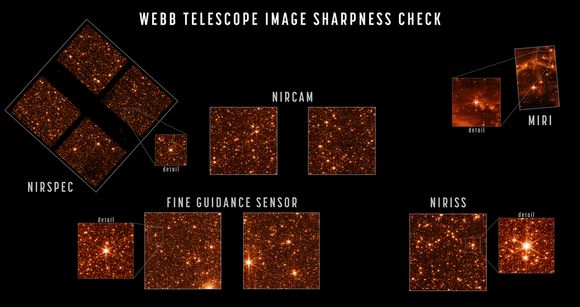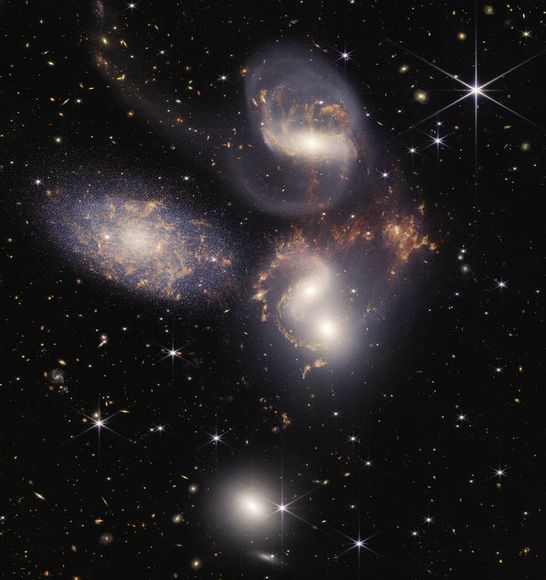The James Webb Space Telescope (JWST) - successor to the Hubble Space Telescope, has after months of cooling down, mirror alignment tweaking and initial instrumentation testing, started to perform 'real science', already sending back astounding images.
The first images were released to the world on July 11th, the honour being given to US president Joe Biden. Amongst the released images; a deep field of galaxies, planetary nebula and galaxy cluster. The alignment of the telescope across all of JWST instruments can be seen below in a series of images that captures the observatory’s full field of view. The images demonstrate that the telescope is fully aligned and in focus showing sharply focused stars in the field of view of each instrument. Certainly no ghosts of the Hubble telescope mirror imperfection here! For the test, Webb pointed at part of the Large Magellanic Cloud, a small satellite galaxy of the Milky Way, providing a dense field of hundreds of thousands of stars across all the observatory’s sensors. The sizes and positions of the images shown here depict the relative arrangement of each of Webb’s instruments in the telescope’s focal plane, each pointing at a slightly offset part of the sky relative to one another.
NASA officials stated that "Webb’s three imaging instruments are NIRCam, NIRISS and Mira, ESA's NIRSpec is a spectrograph rather than imager, but can take images. Darker regions visible in parts of the NIRSpec data are due to structures of its micro shutter array, which has several hundred thousand controllable shutters that control which light is sent into the spectrograph. Lastly, Webb’s Fine Guidance Sensor tracks guide stars to point the observatory accurately and precisely; its two sensors are not generally used for scientific imaging but can take calibration images such as those shown in the above image. This image data is used not just to assess image sharpness but also to precisely measure and calibrate subtle image distortions and alignments between sensors as part of Webb’s overall instrument calibration process".
They also pointed out that "the optical performance of the telescope continues to exceed engineering expectations, the mirrors now directing fully focussing light collected from space down into each instrument, and each instrument is successfully capturing images with the light being delivered to them. The image quality delivered to all instruments is “diffraction-limited,” meaning that the fineness of detail that can be seen is as good as physically possible given the size of the telescope. From this point forward the only changes to the mirrors will be very small, periodic adjustments to the primary mirror segments".
Though telescope alignment is complete telescope calibration activities remain with the Webb team turning its attention to science instrument commissioning. Each instrument is a highly sophisticated set of detectors equipped with unique lenses, masks, filters, and customised equipment that helps it perform the science it was designed to achieve. The specialised characteristics of these instruments will be configured and operated in various combinations during the instrument commissioning phase to fully confirm their readiness for science". The telescope will be commanded to point to different areas in the sky where the total amount of solar radiation hitting the observatory will vary to confirm thermal stability when changing targets. Furthermore, ongoing maintenance observations every two days will monitor the mirror alignment and, when needed, apply corrections to keep the mirrors in their aligned locations.
In the above image JWST produced the deepest and sharpest infrared image of the distant universe to date. Known as Webb’s First Deep Field, the image is of galaxy cluster SMACS 0723 and reveals thousands of galaxies – including the faintest objects ever observed in the infrared. This slice of the vast universe covers a patch of sky approximately the size of a grain of sand held at arm’s length by someone on the ground.
Cloaked in dust and revealed for the first time by JWST, the dimmer star at the center of this scene has been sending out rings of gas and dust for thousands of years in all directions. Two cameras aboard Webb captured the latest image of this planetary nebula, cataloged as NGC 3132, and known informally as the Southern Ring Nebula. It is approximately 2,500 light-years away. JWST will allow astronomers better understanding of more specifics about planetary nebulae - clouds of gas and dust expelled by dying stars. Understanding which molecules are present, and where they lie throughout the shells of gas and dust will help researchers refine their knowledge of these objects.
The JWST largest image to date of Stephan’s Quintet - a visual grouping of five galaxies, is revealed in a new light and covers about one-fifth of the Moon’s diameter. With its powerful, infrared vision and extremely high spatial resolution, Webb shows never-before-seen details in this galaxy group. Sparkling clusters of millions of young stars and starburst regions of fresh star birth grace the image. Sweeping tails of gas, dust and stars are being pulled from several of the galaxies due to gravitational interactions. Most dramatically, Webb captures huge shock waves as one of the galaxies, NGC 7318B, smashes through the cluster.
Captured in infrared light by JWST, this landscape of “mountains” and “valleys” speckled with glittering stars is actually the edge of a nearby, young, star-forming region called NGC 3324 in the Carina Nebula. The image reveals for the first time previously invisible areas of star birth. Called the Cosmic Cliffs, the seemingly three-dimensional picture looks like craggy mountains on a moonlit evening. In reality, it is the edge of the giant, gaseous cavity within NGC 3324, the tallest “peaks” in this image some 7 light-years high. The cavernous area has been carved from the nebula by the intense ultraviolet radiation and stellar winds from extremely massive, hot, young stars located in the center of the bubble, above the area shown in this image.
The science JWST undertakes will be ground breaking, initially concentrating on eight programmes:- two on planetary observations, within our Solar System and Exo-planets and Disks. Galaxies; Intergalactic and Circumgalactic mediums; the large scale structure of the universe; Stellar Physics and Types and populations; the Interstellar medium and Super massive Black holes and Active galaxy nuclei. After just a few weeks of initial observations, we have had a glimpse of the potential of JWST and it's already becoming clear just how much the telescope is going to transform our understanding of the universe and its workings. It's going to be an incredibly exciting first few years in the life of JWST, keep watching!
Images- coutesy of NASA, ESA
- Log in to post comments






